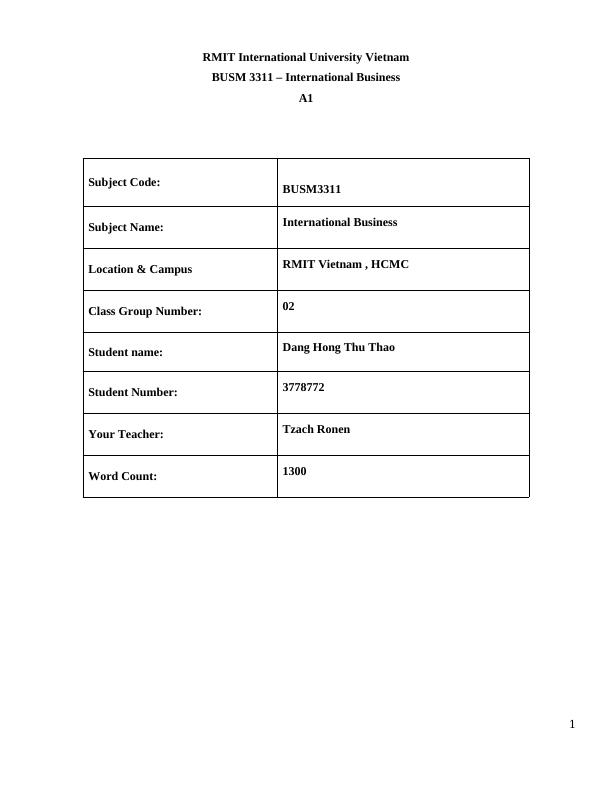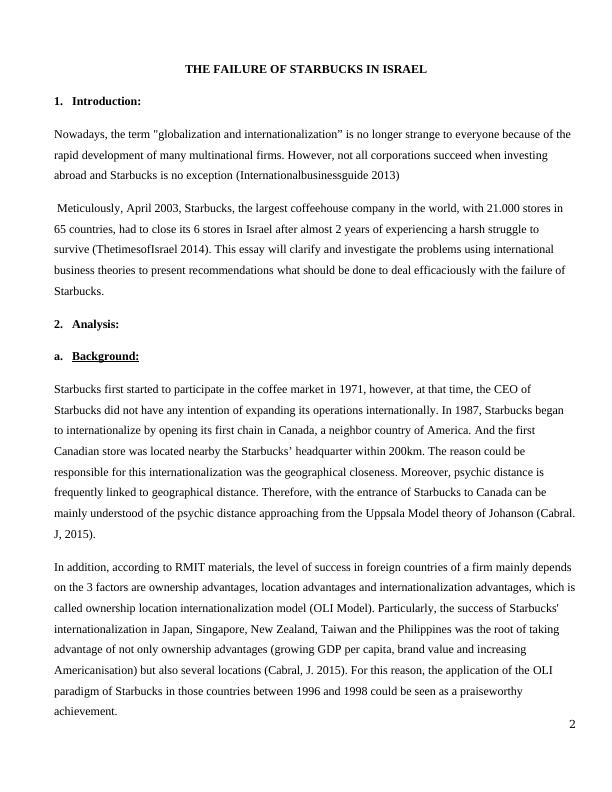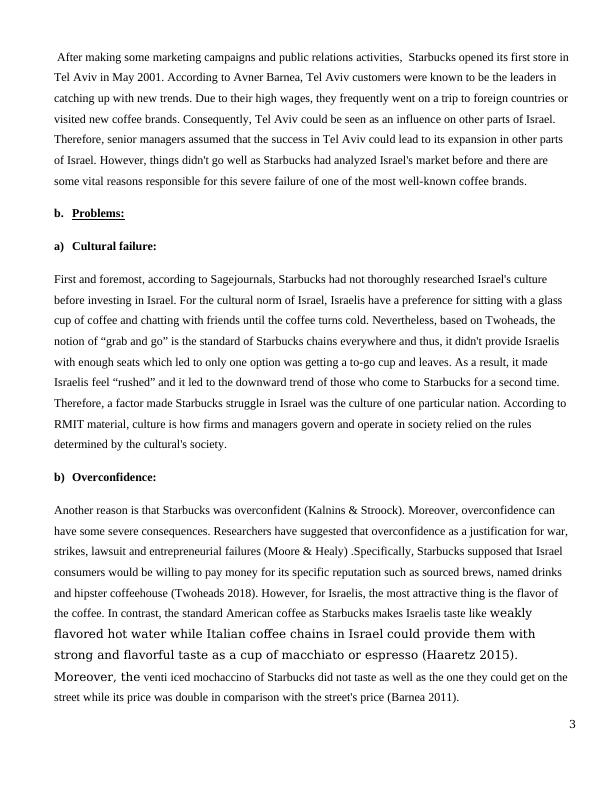Ask a question from expert
BUSM 3311 - International Business Assignment
7 Pages1991 Words147 Views
Added on 2020-11-30
BUSM 3311 - International Business Assignment
Added on 2020-11-30
BookmarkShareRelated Documents
RMIT International University VietnamBUSM 3311 – International BusinessA11Subject Code:BUSM3311Subject Name:International BusinessLocation & Campus RMIT Vietnam , HCMC Class Group Number:02Student name:Dang Hong Thu ThaoStudent Number:3778772Your Teacher:Tzach RonenWord Count: 1300

THE FAILURE OF STARBUCKS IN ISRAEL1.Introduction:Nowadays, the term "globalization and internationalization” is no longer strange to everyone because of the rapid development of many multinational firms. However, not all corporations succeed when investing abroad and Starbucks is no exception (Internationalbusinessguide 2013)Meticulously, April 2003, Starbucks, the largest coffeehouse company in the world, with 21.000 stores in 65 countries, had to close its 6 stores in Israel after almost 2 years of experiencing a harsh struggle to survive (ThetimesofIsrael 2014). This essay will clarify and investigate the problems using international business theories to present recommendations what should be done to deal efficaciously with the failure of Starbucks.2.Analysis:a.Background:Starbucks first started to participate in the coffee market in 1971, however, at that time, the CEO of Starbucks did not have any intention of expanding its operations internationally. In 1987, Starbucks began to internationalize by opening its first chain in Canada, a neighbor country of America. And the first Canadian store was located nearby the Starbucks’ headquarter within 200km. The reason could be responsible for this internationalization was the geographical closeness. Moreover, psychic distance is frequently linked to geographical distance. Therefore, with the entrance of Starbucks to Canada can be mainly understood of the psychic distance approaching from the Uppsala Model theory of Johanson (Cabral.J, 2015).In addition, according to RMIT materials, the level of success in foreign countries of a firm mainly depends on the 3 factors are ownership advantages, location advantages and internationalization advantages, which iscalled ownership location internationalization model (OLI Model). Particularly, the success of Starbucks' internationalization in Japan, Singapore, New Zealand, Taiwan and the Philippines was the root of taking advantage of not only ownership advantages (growing GDP per capita, brand value and increasing Americanisation) but also several locations (Cabral, J. 2015). For this reason, the application of the OLI paradigm of Starbucks in those countries between 1996 and 1998 could be seen as a praiseworthy achievement.2

After making some marketing campaigns and public relations activities, Starbucks opened its first store in Tel Aviv in May 2001. According to Avner Barnea, Tel Aviv customers were known to be the leaders in catching up with new trends. Due to their high wages, they frequently went on a trip to foreign countries or visited new coffee brands. Consequently, Tel Aviv could be seen as an influence on other parts of Israel. Therefore, senior managers assumed that the success in Tel Aviv could lead to its expansion in other parts of Israel. However, things didn't go well as Starbucks had analyzed Israel's market before and there are some vital reasons responsible for this severe failure of one of the most well-known coffee brands.b.Problems:a)Cultural failure:First and foremost, according to Sagejournals, Starbucks had not thoroughly researched Israel's culture before investing in Israel. For the cultural norm of Israel, Israelis have a preference for sitting with a glass cup of coffee and chatting with friends until the coffee turns cold. Nevertheless, based on Twoheads, the notion of “grab and go” is the standard of Starbucks chains everywhere and thus, it didn't provide Israelis with enough seats which led to only one option was getting a to-go cup and leaves. As a result, it made Israelis feel “rushed” and it led to the downward trend of those who come to Starbucks for a second time. Therefore, a factor made Starbucks struggle in Israel was the culture of one particular nation. According to RMIT material, culture is how firms and managers govern and operate in society relied on the rules determined by the cultural's society.b)Overconfidence:Another reason is that Starbucks was overconfident (Kalnins & Stroock). Moreover, overconfidence can have some severe consequences. Researchers have suggested that overconfidence as a justification for war, strikes, lawsuit and entrepreneurial failures (Moore & Healy) .Specifically, Starbucks supposed that Israel consumers would be willing to pay money for its specific reputation such as sourced brews, named drinks and hipster coffeehouse (Twoheads 2018). However, for Israelis, the most attractive thing is the flavor of the coffee. In contrast, the standard American coffee as Starbucks makes Israelis taste like weakly flavored hot water while Italian coffee chains in Israel could provide them with strong and flavorful taste as a cup of macchiato or espresso (Haaretz 2015). Moreover, the venti iced mochaccino of Starbucks did not taste as well as the one they could get on the street while its price was double in comparison with the street's price (Barnea 2011).3

End of preview
Want to access all the pages? Upload your documents or become a member.